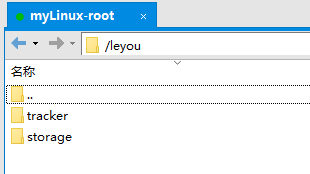CentOs7安装FastDFS5.08并配置nginx访问
目录
版本说明
安装环境
1.安装C语言编译工具
2.安装zip文件的解压命令
3.安装libevent插件
4.新建一个文件夹用于存储
5.上传fastdfs所需文件
6.安装libfastcommon-master
7.安装fastdfs
8.配置中继服务器
9.启动中继服务器
10.配置存储服务器
11.启动存储服务器
使用nginx访问FastDFS
1.安装fastdfs-nginx-module
2.配置nginx与FastDFS关联配置文件
3.配置媒体类型
安装Nginx
1.安装nginx的依赖库
2.解压nginx
3.配置nginx安装包
4.编译并安装nginx
5.编辑nginx配置文件
6.启动nginx
7.设置nginx开机自启动
版本说明
centos: 7.7.1908
fastdfs: 5.08
安装FastDFS
1.安装C语言编译工具
yum install gcc
2.安装zip文件的解压命令
yum install -y unzip zip
3.安装libevent插件
yum -y install libevent
4.新建一个文件夹用于存储
cd /usr/localmkdir leyoucd leyou/
5.上传fastdfs所需文件
6.安装libfastcommon-master
先解压,在leyou目录下输入
unzip libfastcommon-master.zip
然后我们cd进入到解压后的目录中
cd libfastcommon-master先编译
./make.sh
再安装
./make.sh install
7.安装fastdfs
先cd到leyou目录
cd ..
然后解压文件
tar -zxvf FastDFS_v5.08.tar.gzcd进去
cd FastDFS
编译
./make.sh安装
./make.sh install查看是否安装成功
ll /etc/init.d/ | grep fdfs如图代表安装成功~
8.配置中继服务器
在FastDFS文件夹中,先把fastdfs自带的sample配置文件夹模板改名
cp /etc/fdfs/tracker.conf.sample /etc/fdfs/tracker.conf然后我们编辑配置文件
vim /etc/fdfs/tracker.conf修改存储路径为/leyou/tracker
级联创建一个文件夹
mkdir -p /leyou/tracker可以看到在根目录下创建了一个leyou/tracker
查看一下防火墙状态,我们这里选择关闭防火墙
firewall-cmd --state可以看到防火墙是关闭的
9.启动中继服务器
启动服务
service fdfs_trackerd start查看是否启动成功
ps -ef | grep fdfs_trackerd启动成功如图所示
我们设置中继服务器开机自启
chkconfig fdfs_trackerd on
10.配置存储服务器
首先将模板文件复制
cp /etc/fdfs/storage.conf.sample /etc/fdfs/storage.conf修改复制后的配置文件
vim /etc/fdfs/storage.conf在里面需要修改三个配置
修改完成之后,我们级联创建一个文件夹
mkdir -p /leyou/storage根目录下中leyou下就会有2个目录了
11.启动存储服务器
输入启动命令
service fdfs_storaged start输入命令检查是否启动成功
ps -ef | grep fdfs可以看到已经启动成功了
设置开机自启动
chkconfig fdfs_storaged on
使用nginx访问FastDFS
FastDFS使用nginx原因是如果你的FastDFS存储服务器进行了分组。你在1号中上传了文件后,里面会返回给用户上传成功,与此同时会把1号的数据同步到2号。如果在2号没同步完时,你访问了2号,就会导致文件读取出错。
使用nginx根本就是使用fastdfs的ngiinx模块。fastdfs-nginx-module模块可以重定向文件连接到文件上传时的源服务器(1号)取文件,避免客户端由于复制延迟导致的文件无法访问错误
1.安装fastdfs-nginx-module
cd到leyou目录下
cd ..
解压
tar -zxvf fastdfs-nginx-module_v1.16.tar.gz进入到文件夹中
cd fastdfs-nginx-module/src/编辑config文件
vim config
进行全局了路径的替换
:%s+/usr/local/+/usr/+g保存并退出
2.配置nginx与FastDFS关联配置文件
先复制module的配置文件到/etc/fdfs目录中
cp /usr/local/leyou/fastdfs-nginx-module/src/mod_fastdfs.conf /etc/fdfs/修改
vi /etc/fdfs/mod_fastdfs.conf修改以下内容
connect_timeout=20
tracker_server=192.168.62.128:22122
url_have_group_name = true
store_path0=/leyou/storage
3.配置媒体类型
cd /usr/local/leyou/FastDFS/confcp http.conf mime.types /etc/fdfs/
安装Nginx
1.安装nginx的依赖库
yum -y install gcc pcre pcre-devel zlib zlib-devel openssl openssl-devel
2.解压nginx
cd到leyou目录下
cd ../..tar -zxvf nginx-1.10.0.tar.gz
3.配置nginx安装包
cd nginx-1.10.0./configure --prefix=/opt/nginx --sbin-path=/usr/bin/nginx --add-module=/usr/local/leyou/fastdfs-nginx-module/src
4.编译并安装nginx
make && make install
5.编辑nginx配置文件
nginx默认的nginx.conf文件路径在这里
/opt/nginx/conf我们双击打开它,把里面的server完全替换为下面的代码
server {
listen 80;
server_name image.leyou.com;
# 监听域名中带有group的,交给FastDFS模块处理
location ~/group([0-9])/ {
ngx_fastdfs_module;
}
location / {
root html;
index index.html index.htm;
}
error_page 500 502 503 504 /50x.html;
location = /50x.html {
root html;
}
}
6.启动nginx
启动命令就是nginx
nginx下图代表启动成功
再次验证
ps -ef |grep nginx如下图一个主进程一个工作进程代表没问题
7.设置nginx开机自启动
新建一个脚本
vim /etc/init.d/nginx复制如下内容即可,如果你的nginx安装配置路径和我不一样,请自行修改
#!/bin/sh
#
# nginx - this script starts and stops the nginx daemon
#
# chkconfig: - 85 15
# description: NGINX is an HTTP(S) server, HTTP(S) reverse \
# proxy and IMAP/POP3 proxy server
# processname: nginx
# config: /etc/nginx/nginx.conf
# config: /etc/sysconfig/nginx
# pidfile: /var/run/nginx.pid
# Source function library.
. /etc/rc.d/init.d/functions
# Source networking configuration.
. /etc/sysconfig/network
# Check that networking is up.
[ "$NETWORKING" = "no" ] && exit 0
nginx="/usr/bin/nginx"
prog=$(basename $nginx)
NGINX_CONF_FILE="/opt/nginx/conf/nginx.conf"
[ -f /etc/sysconfig/nginx ] && . /etc/sysconfig/nginx
lockfile=/var/lock/subsys/nginx
make_dirs() {
# make required directories
user=`$nginx -V 2>&1 | grep "configure arguments:.*--user=" | sed 's/[^*]*--user=\([^ ]*\).*/\1/g' -`
if [ -n "$user" ]; then
if [ -z "`grep $user /etc/passwd`" ]; then
useradd -M -s /bin/nologin $user
fi
options=`$nginx -V 2>&1 | grep 'configure arguments:'`
for opt in $options; do
if [ `echo $opt | grep '.*-temp-path'` ]; then
value=`echo $opt | cut -d "=" -f 2`
if [ ! -d "$value" ]; then
# echo "creating" $value
mkdir -p $value && chown -R $user $value
fi
fi
done
fi
}
start() {
[ -x $nginx ] || exit 5
[ -f $NGINX_CONF_FILE ] || exit 6
make_dirs
echo -n $"Starting $prog: "
daemon $nginx -c $NGINX_CONF_FILE
retval=$?
echo
[ $retval -eq 0 ] && touch $lockfile
return $retval
}
stop() {
echo -n $"Stopping $prog: "
killproc $prog -QUIT
retval=$?
echo
[ $retval -eq 0 ] && rm -f $lockfile
return $retval
}
restart() {
configtest || return $?
stop
sleep 1
start
}
reload() {
configtest || return $?
echo -n $"Reloading $prog: "
killproc $nginx -HUP
RETVAL=$?
echo
}
force_reload() {
restart
}
configtest() {
$nginx -t -c $NGINX_CONF_FILE
}
rh_status() {
status $prog
}
rh_status_q() {
rh_status >/dev/null 2>&1
}
case "$1" in
start)
rh_status_q && exit 0
$1
;;
stop)
rh_status_q || exit 0
$1
;;
restart|configtest)
$1
;;
reload)
rh_status_q || exit 7
$1
;;
force-reload)
force_reload
;;
status)
rh_status
;;
condrestart|try-restart)
rh_status_q || exit 0
;;
*)
echo $"Usage: $0 {start|stop|status|restart|condrestart|try-restart|reload|force-reload|configtest}"
exit 2
esac
给脚本文件设置权限
chmod 777 /etc/init.d/nginx添加到服务器列表
chkconfig --add /etc/init.d/nginx
设置开机启动
chkconfig nginx on
到此,我们的配置就完成了~










